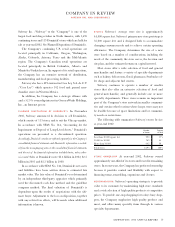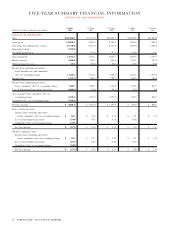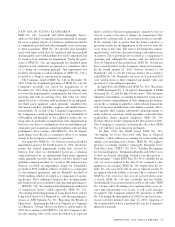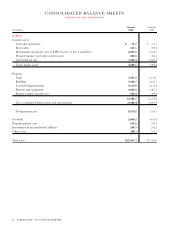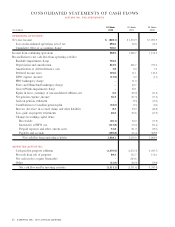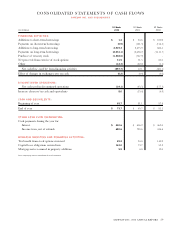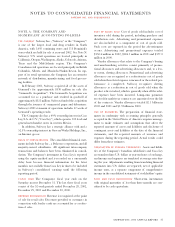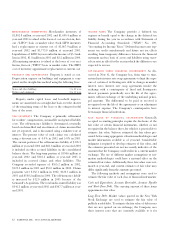Safeway 2002 Annual Report Download - page 24
Download and view the complete annual report
Please find page 24 of the 2002 Safeway annual report below. You can navigate through the pages in the report by either clicking on the pages listed below, or by using the keyword search tool below to find specific information within the annual report.
22 SAFEWAY INC. 2002 ANNUAL REPORT
GOODWILL SFAS No. 142 became effective for Safeway in
the first quarter of 2002. Adoption of this standard changed
our method of accounting for goodwill. Goodwill is no
longer amortized and instead is reviewed for impairment on
an annual basis. Safeway recorded a $700 million charge for
the cumulative effect of adoption of SFAS No. 142 in the
first quarter of 2002 and another $1,288 million goodwill
impairment charge after completing its annual impairment
test in the fourth quarter of 2002. See Note C to the con-
solidated financial statements.
Safeway reviewed goodwill for impairment at the operat-
ing division level. All of the Company’s 2002 goodwill
impairment related to Dominick’s, which the Company is
currently planning to sell, and Randall’s, which had a
remaining goodwill balance of $452.6 million at year-end
2002. Fair value was determined by an independent third
party appraiser which primarily used the discounted cash
flow method and the guideline company method.
The annual impairment review required by SFAS No. 142
requires extensive use of accounting judgments and estimates
of future operating results. Changes in estimates or applica-
tion of alternative assumptions and definitions could produce
significantly different results. The factors that most signifi-
cantly affect the fair value calculation are market multiples
and estimates of future cash flows.
LIQUIDITY AND FINANCIAL RESOURCES
Net cash flow from operating activities was $1,938.1 million
in 2002, $2,150.0 million in 2001 and $1,909.5 million in
2000. Net cash flow from operating activities decreased in
2002 primarily due to changes in working capital. Net cash
flow from operating activities increased in 2001 largely due
to increased net income, partially offset by changes in work-
ing capital.
Cash flow used by investing activities was $1,313.1 million
in 2002, $2,131.6 million in 2001 and $1,337.0 million in
2000. Cash flow used by investing activities decreased in
2002 primarily because of cash used to acquire Genuardi’s in
2001, as well as lower capital expenditures. Cash flow used by
investing activities increased in 2001 over 2000 primarily
because of cash used to acquire Genuardi’s, as well as
increased capital expenditures. Safeway opened 71 new
stores and remodeled 191 stores in 2002. In 2001, Safeway
opened 91 new stores and remodeled 231 stores.
Cash flow used by financing activities was $597.7 mil-
lion in 2002 primarily due to cash flow from operations
being used to pay down debt. Cash flow from financing
activities was $12.1 million in 2001 primarily due to addi-
tional borrowings related to the Genuardi’s Acquisition,
almost entirely offset by cash flow from operations being
used to pay down debt.
Based upon the current level of operations, Safeway
believes that cash flow from operating activities and other
sources of liquidity, including borrowing under the
Company’s commercial paper program and bank credit
agreement, will be adequate to meet anticipated require-
ments for working capital, capital expenditures, interest pay-
ments and scheduled principal payments for the foreseeable
future. There can be no assurance, however, that Safeway’s
business will continue to generate cash flow at or above cur-
rent levels or that the Company will be able to maintain its
ability to borrow under the commercial paper program and
bank credit agreement.
If the Company’s credit rating were to decline below its
current level of Baa2/BBB, the ability to borrow under the
commercial paper program would be adversely affected.
Safeway’s ability to borrow under the bank credit agreement
is unaffected by Safeway’s credit rating. However, if
Safeway’s 2002 Adjusted EBITDA (as defined in Safeway’s
bank credit agreement) to interest ratio of 7.68 to 1 were to
decline to 2.0 to 1, or if Safeway’s year-end 2002 debt to
Adjusted EBITDA ratio of 2.55 to 1 were to grow to 3.5 to
1, Safeway’s ability to borrow under the bank credit agree-
ment would be impaired.
The table below presents significant contractual obligations of the Company at year-end 2002:
(In millions) 2003 2004 2005 2006 2007 Thereafter Total
Long-term debt $780.3 $699.6 $232.5 $2,479.7 $ 785.0 $2,812.4 $7,789.5
Capital lease obligations(1) 25.2 27.1 28.6 29.3 29.2 398.1 537.5
Operating leases 341.7 332.7 317.1 299.4 279.5 2,542.7 4,113.1
Contracts for purchase of property,
equipment and construction of buildings 129.1 –––––129.1
(1) Minimum lease payments, less amounts representing interest.



